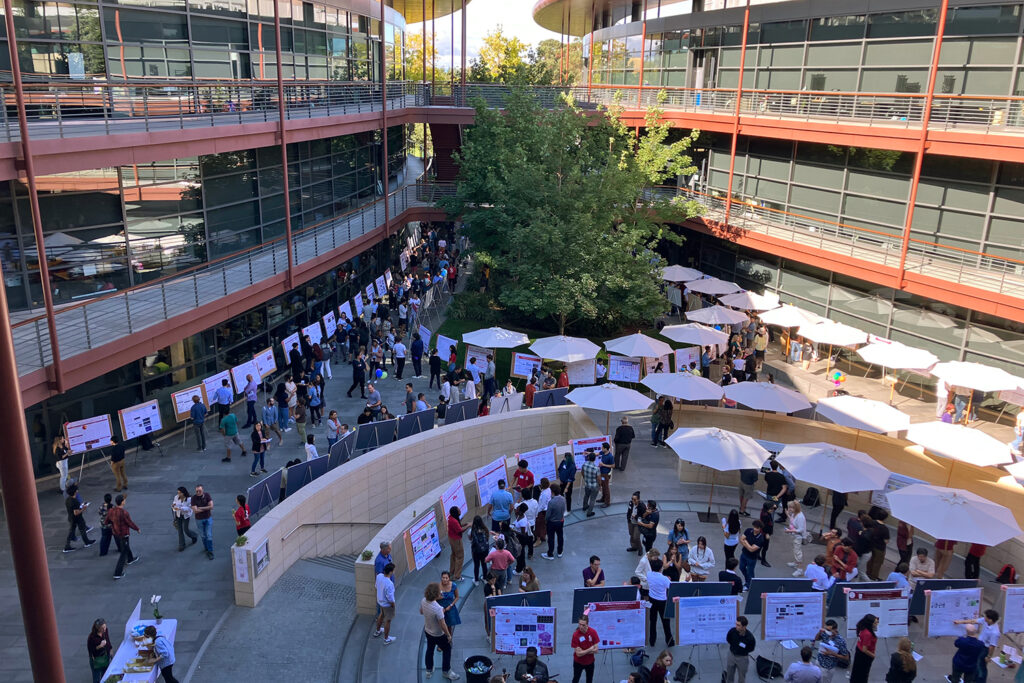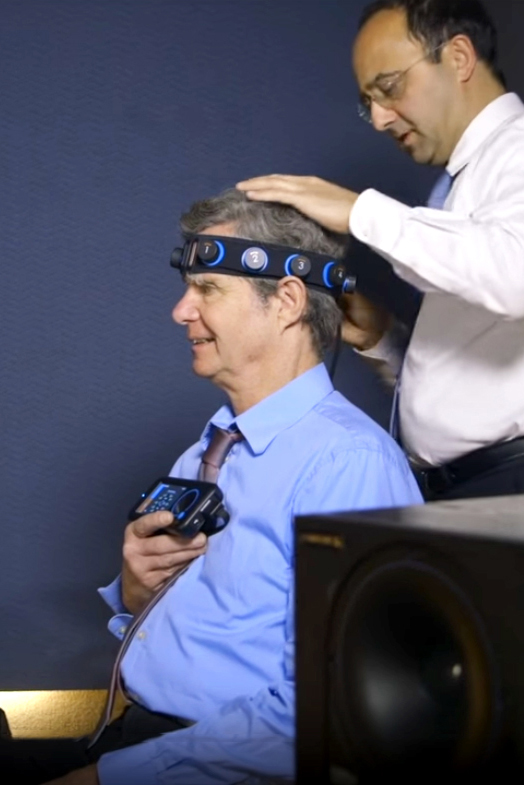A quarter century of Bio-X community science
After 25 years of transformational research, Stanford Bio-X is still fueling new ideas and changing lives through a scientific community like no other.

The annual Bio-X poster session draws attendees from all over campus to engage with research and creative projects. (Image credit: Courtesy Stanford Bio-X)
In 2008, neurologist Josef Parvizi sat in Memorial Auditorium listening to Kronos Quartet when he had the inspiration for what would become the brain stethoscope. He imagined a device that could turn brainwaves into sounds – music – that could help health care practitioners diagnose at the bedside “silent seizures” that strike without external symptoms of an ongoing seizure.
Before the brain stethoscope could be realized, Parvizi needed a partner who understood how to create sound waves from data, and he needed seed funding to get his idea off the ground. For the first, he turned to Chris Chafe, a professor of music in the School of Humanities and Sciences and composer of “Earth Symphony” – a “sonification” of climate change based on 800,000 years of data frozen in ancient ice.
“It is a long path from idea to device,” Chafe recalls. “We needed brainwave data, but we needed to gather it non-invasively, outside the scalp, to convert the brainwaves to sound quickly.”
On the funding side, Parvizi met a dead end. Traditional sources were out of reach. That’s when Parvizi and Chafe came to Stanford Bio-X, then a pioneering interdisciplinary community of life sciences researchers, clinicians, engineers, physicists, computational scientists, artists, and more – any researcher really – dedicated to exploring the human body in new ways. In Bio-X, Parvizi found a community of like-minded scientists who not only encouraged cross-disciplinary collaborations, but demanded them.
“The precise goal of Bio-X is to give money to risky and out-there, but promising, ideas that might become life-changing products,” Parvizi said. “One day, Bio-X gave us a small seed grant, but then the seed grew into a large tree. Ten-plus years later, its fruits are in hundreds of hospitals. Suddenly, this spark of an idea becomes a startup which in 2024 employs 220-plus people in the United States, making life better for countless patients and saving lives.”
Chafe added, “Bio-X provided us the scientific freedom to explore that idea.”

Neurology Professor Josef Parvizi places sensors on the head of music Professor Chris Chafe. The recording device acts as a brain stethoscope, converting brain waves into sounds that allow anyone to diagnose seizures. (Image credit: Kurt Hickman)
A new mindset
On March 28, Bio-X celebrates its 25th year of transformational science. From the start, Bio-X understood that the academic alchemy that can bring together unlikely disciplines — like neurology and music — can also produce new knowledge of the human body that is far greater than the sum of its parts.
“The Bio-X community champions curiosity, integrity, and collaboration in its pursuit of novel discoveries and important advances in human health,” said Stanford President Richard Saller. “As Stanford’s first interdisciplinary biosciences institute, it has also served as a model for collaboration across fields more broadly. I congratulate the faculty, postdocs, students, and staff who built this remarkable legacy.”
The core principle that defined Bio-X then is the same that drives it today, said Bio-X faculty director Carla Shatz.
“From engineering to medicine, tenured professor to undergraduate, it is our community that sets Bio-X apart,” added Shatz, who steps down this year after directing Bio-X for 17 years. “A quarter century ago, the concept of such an interdisciplinary community at a single university was a novel idea, even for Stanford. But that’s what we built — a community. Bio-X was a new mindset.”
That community now includes over 1,300 faculty from 75 departments across every one of Stanford’s seven schools. The 252 Bio-X seed grants awarded to date have united interdisciplinary teams comprising 1,000 faculty members and Bio-X has funded fellowships for 570 post-doctoral scientists, 955 graduate students, and more than 1,000 undergraduates.
“Bio-X embodies Stanford’s commitment to interdisciplinary research and education for the benefit of society,” said David Studdert, vice provost and dean of research. “The institute is, in essence, a community that brings together people from different schools, departments, and disciplines to achieve things none of them could achieve alone.”
Over the years, the community has flourished with support from investments by Stanford leadership and the contributions of an active advisory council passionate about ideas and talent flowing through the institute.
“Bio-X was founded by a few forward-thinking faculty members and remains true to its original vision,” said Heideh Fattaey, executive director of Bio-X. “It has been, and continues to be, supported and fueled by our exceptional leadership, nurtured and grown by our innovative faculty, postdocs, and students, and fully supported by its extremely passionate staff. It has been a collective effort, with everyone working together toward a common goal: uniting people from across our schools and departments to collaborate as one unified university.”
Nowhere else
Few can appreciate the full weight of the Bio-X community better than Jesse Engreitz, an assistant professor of genetics and investigator in the Basic Sciences and Engineering (BASE) Initiative at the Betty Irene Moore Children’s Heart Center. His lab is mapping the human genome’s regulatory code to understand heart development and disease and, potentially, to design genome therapies to cure them.
Fourteen years ago, Engreitz was a Stanford undergrad with a nascent interest in biology and computer science. Engreitz had few academic role models, but a Bio-X undergraduate fellowship allowed him to explore both interests.
Bio-X placed Engreitz with Russ Altman, a physician scientist and professor of bioengineering who was using data to explore the genes controlling how the body metabolizes medications. Altman’s lab was investigating the difficult-to-dose blood thinner, Warfarin, trying to better predict dosages for patients based on their DNA profile.
The more Engreitz got to know Altman and to work with him, the more he grew fascinated by this notion of personalized medicine. The two would pore over findings and discuss new directions during regular research meetings.
“That was my first research experience,” Engreitz said. “I did not understand what science was and what an academic track might look like. It wasn’t really on my radar to pursue academic science.”
Engreitz’s Bio-X experience led to a master’s thesis and then to a doctorate at MIT, and then back to California as a Stanford professor. Engreitz now runs a thriving lab rooted in the principles he learned at Altman’s side.
“I got hooked on decoding the human genome,” Engreitz said. “Where else was an undergraduate going to get that kind of experience in combining biology and computer science? Bio-X made it possible.”
Life illuminated
Optogenetics is one of the most profound scientific advances of recent decades. Bio-X is proud to have been an early supporter of bioengineer Karl Deisseroth when he was a new faculty member just gaining recognition for implanting light-sensitive genes into living neurons, which allowed him to turn brain circuits on and off with light.
Optogenetics’ origin story is but the tip of a scientific iceberg that grew as optogenetics spread across the world and scientists began to use it to make transformative discoveries.
Bio-X has been there along the way, including supporting Deisseroth’s fruitful collaboration with Stanford engineer Scott Delp, director of the Wu Tsai Human Performance Alliance and one of the world’s foremost experts in the biomechanics of human movement.
As chair of the Department of Bioengineering, Delp had helped woo Deisseroth to Stanford. But their scientific collaboration did not begin until later, through the work of graduate student Kate Montgomery who was splitting time between three different labs under a Bio-X Graduate Fellowship.
Delp and Deisseroth have now published 14 papers together. Two were published with Montgomery as first author in 2015 and 2016, exploring the use of optogenetics on neural circuits of the spinal cord and peripheral nervous system, offering tantalizing “therapeutic potential” beyond the reach of current clinical care.
“Kate was a truly creative student, and her three-year Bio-X Fellowship allowed her to bridge our labs to explore novel ideas that wouldn’t get funded otherwise,” Delp explained. “The Bio-X funding of brilliant students to explore unexplored frontiers is a scientific super-power Bio-X provides.”
“Bio-X is a wonderful engine for collaborative research,” Deisseroth adds. “It has been driving science forward for 25 years.”
Carla Shatz is the Sapp Family Provostial Professor and professor of biology in H&S and of neurobiology in the School of Medicine. She is also the Catherine Holman Johnson Director of Stanford Bio-X.